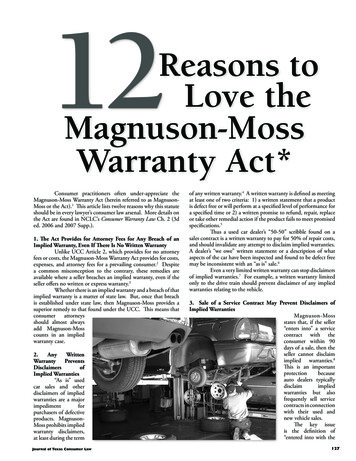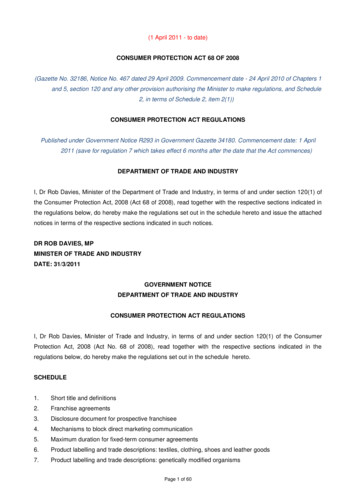
Transcription
(1 April 2011 - to date)CONSUMER PROTECTION ACT 68 OF 2008(Gazette No. 32186, Notice No. 467 dated 29 April 2009. Commencement date - 24 April 2010 of Chapters 1and 5, section 120 and any other provision authorising the Minister to make regulations, and Schedule2, in terms of Schedule 2, item 2(1))CONSUMER PROTECTION ACT REGULATIONSPublished under Government Notice R293 in Government Gazette 34180. Commencement date: 1 April2011 (save for regulation 7 which takes effect 6 months after the date that the Act commences)DEPARTMENT OF TRADE AND INDUSTRYI, Dr Rob Davies, Minister of the Department of Trade and Industry, in terms of and under section 120(1) ofthe Consumer Protection Act, 2008 (Act 68 of 2008), read together with the respective sections indicated inthe regulations below, do hereby make the regulations set out in the schedule hereto and issue the attachednotices in terms of the respective sections indicated in such notices.DR ROB DAVIES, MPMINISTER OF TRADE AND INDUSTRYDATE: 31/3/2011GOVERNMENT NOTICEDEPARTMENT OF TRADE AND INDUSTRYCONSUMER PROTECTION ACT REGULATIONSI, Dr Rob Davies, Minister of Trade and Industry, in terms of and under section 120(1) of the ConsumerProtection Act, 2008 (Act No. 68 of 2008), read together with the respective sections indicated in theregulations below, do hereby make the regulations set out in the schedule hereto.SCHEDULE1.Short title and definitions2.Franchise agreements3.Disclosure document for prospective franchisee4.Mechanisms to block direct marketing communication5.Maximum duration for fixed-term consumer agreements6.Product labelling and trade descriptions: textiles, clothing, shoes and leather goods7.Product labelling and trade descriptions: genetically modified organismsPage 1 of 60
8.Disclosure of reconditioned or grey market goods9.Information to be disclosed by intermediary10.Records to be kept by intermediary11.Promotional competitions12.Cautionary statement for alternative work schemes13.Interpretation: Fraudulent Schemes and Offers14.Prohibition on intermediary arranging transport contracts15.Public property syndication schemes16.Prohibition on feasibility studies promising funding17.Calculation of interest for multiplication scheme18.Definitions, interpretation and application: auctions19.Mandatory advertising of auctions20.General rules on advertising of auctions21.Rules of auction22.Auctioneer and auction house to hold and account for consumer’s property23.Disqualification to conduct auction24.Prohibited behaviour25.False entry in auction record26.Bidder’s record27.Ownership28.Bidding29.Mock auction30.Internet or electronic auctions31.Records32.Motor vehicle auctions33.Livestock, game and closed auctions34.Maximum amount of cancellation penalty for lay-by’s35.Initiating complaint to Commission36.Investigation by Commission37.Outcome of investigation38.Standards, procedures and related matters for Commission to follow in assessing applicant foraccreditation as consumer protection group39.Form, manner and fee to register business names40.Notice to cancel registration41.Official languages to be used by Commission in documents42.Compliance notice43.Confidentiality Claim44.Notice from the Chairperson: Civil actions45.List of contract terms which are presumed not to be fair and reasonableANNEXURESPage 2 of 60
Annexure A -Regulation 4(2)Annexure B -Section 14(4)(c)Annexure C -Section 16Annexure D -Regulation 6(1)Annexure E -Regulation 35Annexure F-Regulation 36Annexure G -Regulation 37Annexure H -Regulation 39Annexure I -Regulation 40(1)Annexure J -Regulation 40(2)Annexure K -Section 88Annexure L -Regulation 42Annexure M -Regulation 431.Short title and definitions(1)These regulations are the Consumer Protection Act Regulations.(2)In these regulations, unless the context indicates otherwise, any word or expression to which ameaning has been assigned in the Act has the same meaning, and”Act” means the Consumer Protection Act, 2008 (Act No. 68 of 2008);“Department” means the Department of Trade and Industry;“in writing” includes any electronic means recognised by the Electronic Communications andTransactions Act, 2002 (Act No. 25 of 2002); and“public officer” means that person defined in Chapter III (General Provisions) of Part V of the IncomeTax Act, 1962 (Act 58 of 1962).2.Franchise agreements(1)This regulation must be read together with sections 7 and 120(1)(e)(ii) of the Act.(2)(a)Every franchise agreement must contain the exact text of section 7(2) of the Act at the top of thefirst page of the franchise agreement, together with a reference of the section and the Act.(b)A franchise agreement must contain provisions which prevent -(i)unreasonable or overvaluation of fees, prices or other direct or indirect consideration;Page 3 of 60
(ii)conduct which is unnecessary or unreasonable in relation to the risks to be incurred byone party; and(iii)conduct that is not reasonably necessary for the protection of the legitimate businessinterests of the franchisor, franchisee or franchise system.(c)A franchise agreement must contain a clause informing a franchisor that he, she or it is notentitled to any undisclosed direct or indirect benefit or compensation from suppliers to itsfranchisees or the franchise system, unless the fact thereof is disclosed in writing with anexplanation of how it will be applied.(d)Paragraph 2 of item 3 of Schedule 2 of the Act applies to any pre-existing franchise agreement.(e)Any provision in a franchise agreement to which these regulations apply which is in conflict withthis regulation is void to the extent of such a conflict.(3)A franchise agreement must as a minimum contain the following specific information -(a)the name and description of the types of goods or services which the franchisee is entitled toprovide, produce, render or sell;(b)the obligations of the franchisor;(c)the obligations of the franchisee;(d)a description of the applicable franchise business system;(e)the direct or indirect consideration payable by the franchisee to the franchisor;(f)the territorial rights, if any, granted to the franchisee in detail;(g)a description of the site or premises and location from which the franchisee is to conduct thefranchise;(h)the conditions under which the franchisee or his, her or its estate may transfer or assign therights and obligations under the franchise;(i)a description of the trade mark or any other intellectual property owned by the franchisor, orotherwise licensed to the franchisor which is, or will be used in the franchise, and the conditionsunder which they may so be used;(j)if the agreement is related to a master franchise, the master franchisor’s identity;Page 4 of 60
(k)particulars of the initial training and assistance provided by the franchisor and, where thefranchisor provides ongoing training for the duration of the franchise agreement, a statementthat the particulars of such training and assistance will be provided to the franchisee as andwhen necessary;(l)the duration and the terms of the renewal of the franchise agreement, provided that such termsand conditions are not inconsistent with the purpose and policy of the Act;(m)if the franchise agreement provides that a franchisee must directly or indirectly contribute to anadvertising, marketing or other similar fund, the franchise agreement must contain clausesinforming the franchisee -(i)of the amount, or if expressed as a percentage, the method of calculation of suchcontribution;(ii)that within six months after the end of the last financial year, the franchisor will provide afranchisee with a copy of a financial statement, prepared in accordance with applicablelegislation, which fairly reflects the fund’s receipts and expenses for the last financialyear, including amounts spent, and the method of spending on advertising and/ormarketing of franchisees and the franchise system’s goods and services,(iii)that, in addition to subparagraph (ii), the franchisor must for every three months periodmake financial management accounts relating to the funds available to franchisees;(iv)that moneys in the fund may not be spent on advertising and marketing of the franchisor’sfranchises for sale;(v)that to the extent that an audit is carried out, a certificate of a registered auditor oraccounting officer, as the case may be, confirming that the fund’s account has beenaudited and that the statements, to the best of his or her knowledge, provide a truereflection of the matters stated in this subregulation (m) and where no audit is carried out,a certificate by the accountant that management accounts have been prepared and arecorrect to the best of the directors’ knowledge;(vi)that a franchisee can request a copy of the statement and certificate issued in terms ofsubregulation (v), and that the franchisor must within a reasonable period of such requestprovide such copies;(vii)of any contribution to such a fund will be deposited in a separate bank account and usedonly for purposes of the fund;Page 5 of 60
(viii)of the franchisor’s contribution to such fund, if any; and(ix)of the fact that the franchisor and or franchisor associated franchised businesses do notenjoy any direct or indirect benefit not afforded to independent franchisees;(n)the effect of the termination or expiration of the franchise;(o)extension or renewal terms, or whether there is no option to renew or extend the agreement;(p)a written explanation of any terms or sections not fully understood by the prospective franchiseeupon the prospective franchisee’s written request;(q)the franchisor’s legal name, trading name, registered office and franchise business office, streetaddress, postal address, e-mail address, telephone number and fax number;(r)the name, identity number, town of residence, job titles and qualifications of the franchisor’sdirectors or equivalent officers;(s)except where the franchisor is a company listed on a stock exchange, details of any proprietor,member or shareholder if they are different from the persons referred to in paragraph (r);(t)particulars of any restrictions imposed on the franchisee;(u)the nature and extent of the franchisor’s involvement or approval in the process of site selection;(v)the terms and conditions relating to termination, renewal, goodwill and assignment of thefranchise;(w)the main obligations of the franchisor in respect of initial and ongoing training to be provided;(x)confirmation that any deposits paid by the prospective franchisee will be deposited into aseparate bank account and a description of how these deposits will be dealt with;(y)full particulars of the financial obligations of the franchisee in terms of the franchise agreementor otherwise related to the franchised business including -(i)the initial fee payable to the franchisor on the signing of the franchise agreement,including the purpose for which it is to be applied;(ii)the funds required to establish the franchised business including, purchase or lease ofproperty, site conversion costs, decor and signage, equipment, furniture, hiring andtraining of staff, opening stock, legal and financial charges, as may be applicable;Page 6 of 60
(iii)the initial working capital, where possible, and the basis on which it is calculated;(iv)the total investment required;(v)a clear statement as to whether or not any expenses, any salary/wages of employees ofthe franchised business and the costs of servicing loans are included in the purchaseprice.(vi)the amount of funding that is available from the franchisor, if any, and the applicableconditions;(vii)the total amount that the franchisee must contribute towards the necessary fundingbefore borrowing; and(viii)ongoing amounts payable to the franchisor, with details as to -(aa)whether the amounts are fixed or variable;(bb)whether all or part of the amounts are included in the price of goods or servicesthat must be purchased from the franchisor or other preferred suppliers;(cc)the dates, or intervals, at which the amounts fall due; and(dd)if any fee is payable in respect of management services provided by the franchisor,details of such services.(4)A franchise agreement which is renewed after the general effective date is a new franchise agreementfor the purposes of subregulations (2) and (3).3.Disclosure document for prospective franchisee(1)Every franchisor must provide a prospective franchisee with a disclosure document, dated and signedby an authorised officer of the franchisor, at least 14 days prior to the signing of a franchiseagreement, which as a minimum must contain -(a)the number of individual outlets franchised by the franchisor;(b)the growth of the franchisor’s turnover, net profit and the number of individual outlets, if any,franchised by the franchisor for the financial year prior to the date on which the prospectivefranchisee receives a copy of the disclosure document;Page 7 of 60
(c)a statement confirming that there have been no significant or material changes in thecompany’s or franchisor’s financial position since the date of the last accounting officer, orauditor’s certificate or certificate by a similar reviewer of the company or franchisor, that thecompany or franchisor has reasonable grounds to believe that it will be able to pay its debts asand when they fall due;(d)written projections in respect of levels of potential sales, income, gross or net profits or otherfinancial projections for the franchised business or franchises of a similar nature with particularsof the assumptions upon which these representations are made.(2)Each page of the disclosure document contemplated in subregulation (1) above must be qualified inrespect of the assumptions contained therein.(3)The disclosure document contemplated in subregulation (1) above must be accompanied by acertificate on an official letterhead from a person eligible in law to be registered as the accountingofficer of a close corporation, or the auditor of a company, as the case may be, certifying that -(a)the business of the franchisor is a going concern;(b)to the best of his or her knowledge the franchisor is able to meet its current and contingentliabilities;(c)the franchisor is capable of meeting all of its financial commitments in the ordinary course ofbusiness as they fall due; and(d)the franchisor’s audited annual financial statements for the most recently expired financial yearhave been drawn up -(i)in accordance with South African generally accepted accounting standards;(ii)except to the extent stated therein, on the basis of accounting policies consistent withprior years;(iii)in accordance with the provisions of the Companies Act (No. 61 of 1973 or any legislationwhich replaces this Act), and all other applicable laws; and(iv)fairly reflecting the financial position, affairs, operations and results of the franchisor as atthat date and for the period to which they relate.(4)The disclosure document contemplated in subregulation (1) above must be accompanied by -Page 8 of 60
(a)a list of current franchisees, if any, and of outlets owned by the franchisor, stating, in respect ofany franchisee -(i)the name under which it carries on business;(ii)the name of its representative;(iii)its physical address; and(iv)its e-mail and office telephone number, together with a clear statement that theprospective franchisee is entitled to contact any of the franchisees listed, or alternativelyto visit any outlets operated by a current franchisee to assess the information disclosedby the franchisor and the franchise opportunity offered by it;(b)an organogram depicting the support system in place for franchisees.4.Mechanisms to block direct marketing communication(1)For purposes of section 11(1) and 11(2) of the Act, if a consumer has -(a)informed the direct marketer; or(b)placed any communication or sign on a postal box, post office box or other container for mail,indicating that he or she does not wish to receive any material related to direct marketing, then thedirect marketer -(i)may not place or attach any material primarily aimed at direct marketing, in whichever physicalformat, in or on or near the postal box, post office box, container, or in, on or near the fence,gate or any other part of the premises of the consumer; and(ii)must provide the consumer with written confirmation of the receipt by the direct marketer of thenotice referred in paragraph (a) above.(2)Display of the phrase “no adverts” or the image or a similar reproduction thereof prescribed inAnnexure A is sufficient to meet the requirements of paragraph (b) of subregulation (1).(3)For purposes of section 11(6) of the Act, the following principles are required as a minimum for theoperation of a registry contemplated in section 11(3):(a)the registry must be capable of accommodating all persons in the Republic and cover the wholegeographical area of the Republic;Page 9 of 60
(b)the registry must at all times be accessible to all persons in the Republic for purposes ofregistering a pre-emptive block, without payment of any fee, but the person registering must paythe actual cost of the type of communication available for registration;(c)a consumer may register -(i)his or her name, identification number, passport number, telephone number, cell phonenumber, facsimile number, e-mail address, postal address, physical address, a websiteuniform resource locator (“URL”) or any other identifier which the operator of the registrymakes provision for;(ii)the consumer’s own global address for any website or web application or site on theworld wide web;(iii)if the operator of a registry so allows, a pre-emptive block for any time of the day or anyday of the year; or(iv)if the operator of a registry so allows, a comprehensive prohibition for any medium ofcommunication, address or time whatsoever;(d)any pre emptive block registered in accordance with this regulation becomes effective 30 daysfrom the date on which it is registered;(e)the administrator of the registry may not under any circumstances whatsoever provide, sell, orotherwise dispose of any information contemplated in subregulation (c) to anyone, including anyorgan of state, except with the written and express permission of the consumer concerned, byorder of a court of law or the operation of law;(f)the administrator of the registry may, on receipt of an application, only confirm whether or not apre-emptive block has been registered by the consumer, and may not provide any detail to thedirect marketer in respect of any identifier provided by the consumer to the registry;(g)except in respect of those existing clients where the direct marketer has proof that the existingclient has after the commencement of these regulations expressly consented to receiving directmarketing from the direct marketer, a direct marketer must assume that a comprehensive preemptive block has been registered by a consumer unless the administrator of the registry has inwriting confirmed that a pre-emptive block has not been registered in respect of a particularname, identity number, fixed line telephone number, cellular telephone number, facsimilenumber, pager number, physical address, postal address, e-mail address, website uniformresource locator (URL) global positioning system co-ordinates or other identifier which thePage 10 of 60
operator of the registry makes provision for submitted by the direct marketer for purposes ofsubregulation (f);(h)the administrator of the registry must on request provide a consumer with a copy of anapplication contemplated in subregulation (f) as well as a copy of the administrator’s reply, theidentity and registered address of the direct marketer who has submitted that application, andthe name and contact details of the responsible person contemplated in subregulation (i);(i)upon payment of a prescribed fee, if any, every direct marketer must register with theadministrator of the registry as such, and must supply his, her or its postal and physicalbusiness address, telephone number, facsimile number, e-mail address, and the name of aperson who is responsible for any applications to be lodged under this regulation, and thetelephone number, facsimile number, e-mail address of that responsible person;(j)every direct marketer must annually on the date of registration in writing confirm the detailscontemplated in subregulation (i);(k)the registry may not accept an application from a direct marketer who has not been registeredby the administrator as a direct marketer as provided for in subregulation (i) or confirm thedetails as contemplated in subregulation (j);(l)the administrator of the registry must at any time allow an employee of the Commission in thecourse and scope of what is required in executing their duties, and allow him or her to makeexcerpts or copies of such records;(m)the prohibition contained in subregulation (f) does not apply in respect of information requestedby a consumer himself or herself.(4)The administrator of the registry must -(a)pro-actively and to the satisfaction of the Commission put in place sufficient securityarrangements to prevent the manipulation, theft or loss of data in the registry;(b)pro-actively put in place screening and validation processes in respect of any person applying toregister as a direct marketer;(c)comply with any law providing for the protection of personal information or the protection ofprivacy; and(d)from time to time in all official languages conduct a public information campaign as required andapproved by the Commission.Page 11 of 60
(5)In the event that the Commission recognises a registry as authoritative as contemplated in section11(3) of the Act, the Commission must enter into an agreement with the administrator of that registryinter alia to -(a)expressly agree and confirm that the Commission, despite anything to the contrary, remains thesole custodian of all information collected and that the administrator has no rights or legitimateexpectations whatsoever in respect of the use, disposal, retention or publication of allinformation whatsoever collected by the administrator of the registry during the period of theagreement, and that the Commission at all times ultimately remains in control of the registry;(b)ensure full compliance with the Act, this regulation and all other relevant law;(c)ensure, with appropriate sanction, that the administrator of the registry or any of itsshareholders, members, affiliates or interested parties may not financially or otherwise in anyway whatsoever benefit from administering the registry other than receiving payment from theCommission for rendering that service;(d)ensure the implementation of, to the satisfaction of the Commission, screening and validationprocesses in respect of any person -(i)applying to register as a direct marketer;(ii)employed or engaged by the administrator to work with information collected in theregistry;(e)ensure that appropriate and effective mechanisms, procedures and processes are continuouslymaintained by the administrator to ensure the availability, safety, retention and physical andmoral integrity of all information collected and administered by the administrator, to thesatisfaction of the Commission;(f)provide the Commission and the Department with full and immediate access to the whole of theregistry, and the premises and apparatus in or on which it is retained or backed up;(g)provide that the administrator of the registry must immediately upon termination of theagreement, in respect of all information whatsoever collected by the administrator of the registryduring the period of the agreement to the Commission, as directed by the Commission, -(i)surrender all information whatsoever that it has collected during the period of theagreement to the Commission in any format directed by the Commission;(ii)fully and in the utmost good faith co-operate with the Commission to ensure theuninterrupted availability of the registry to the general public and to direct marketers;Page 12 of 60
(h)provide for adequate controls and oversight mechanisms;(i)provide for verifiable service levels and standards;(j)provide for appropriate and effective sanctions should applicable law and the agreement in anyway not fully be complied with by the administrator of the registry;(k)provide for effective mechanisms for the general public to report problems with theadministration of the registry to the Commission;(l)provide for the way in which the administrator may publish and market the recognition of itsregistry as authoritative; and(m)(6)provide for any other matter the Commission deems necessary or expedient.Nothing in this regulation should be interpreted as restricting the Commission’s responsibility for oraccountability in respect of the registry.5.Maximum duration for fixed-term consumer agreements(1)For purposes of section 14(4)(a) of the Act, the maximum period of a fixed-term consumer agreementis 24 months from the date of signature by the consumer -(a)unless such longer period is expressly agreed with the consumer and the supplier can show ademonstrable financial benefit to the consumer;(b)unless differently provided for by regulation in respect of a specific type of agreement, type ofconsumer, sector or industry; or(c)as provided for in an industry code contemplated in section 82 of the Act in respect of specifictype of agreement, type of consumer, sector or industry.(2)For purposes of section 14(3), a reasonable credit or charge as contemplated in section 14(4)(c) maynot exceed a reasonable amount, taking into account -(a)the amount which the consumer is still liable for to the supplier up to the date of cancellation;(b)the value of the transaction up to cancellation;(c)the value of the goods which will remain in the possession of the consumer after cancellation;Page 13 of 60
(d)the value of the goods that are returned to the supplier;(e)the duration of the consumer agreement as initially agreed;(f)losses suffered or benefits accrued by consumer as a result of the consumer entering into theconsumer agreement;(g)the nature of the goods or services that were reserved or booked;(h)the length of notice of cancellation provided by the consumer;(i)the reasonable potential for the service provider, acting diligently, to find an alternativeconsumer between the time of receiving the cancellation notice and the time of the cancelledreservation; and(j)(3)the general practice of the relevant industry.Notwithstanding subregulation (2) above, the supplier may not charge a charge which would have theeffect of negating the consumer’s right to cancel a fixed term consumer agreement as afforded to theconsumer by the Act.6.Product labelling and trade descriptions: textiles, clothing, shoes and leather goods(1)In order to assist consumers in making informed decisions or choices, for purposes of subsections (4)and (5) of section 24 of the Act and subject to subregulation (2), the importation into or the sale in theRepublic of the goods specified in Annexure “D”, irrespective of whether such goods weremanufactured or adapted in the Republic or elsewhere, is prohibited unless -(a)a trade description, meeting the requirements of section 22 of the Act, is applied to such goodsin a conspicuous and easily legible manner stating clearly-(i)the country in which they were manufactured, produced or adapted;(ii)in the event of a textile manufacturer, importer or seller operating in the Republic usingimported greige fabric to produce dyed, printed or finished fabric in the Republic, thatsuch fabric has been dyed, printed or finished in South Africa from imported fabric; and(iii)that a locally manufactured product using imported material must state “Made in SouthAfrica from imported materials”;Page 14 of 60
(b)such goods conform to the South African national standards for fibre content and care labellingin accordance with the provisions of Government Notice No. 2410 of 2000, published in theGazette of 30 June 2000;(c)if after such goods have been reconditioned, adapted, rebuilt or remade, whether in theRepublic or elsewhere, a trade description is applied to such goods in a conspicuous and easilylegible manner stating clearly that such goods have so been reconditioned, adapted, rebuilt orremade, as the case may be;(d)if the goods were wholly assembled or made in the Republic, a trade description is applied tosuch goods in a conspicuous and easily legible manner stating “Made in South Africa.”; or(e)(2)goods are correctly labelled.This regulation does not apply to -(a)textiles so small in size that labelling is not reasonably possible;(b)second-hand clothing imported for charity purposes; or(c)goods where the number of goods imported by a natural person does not exceed 1000 singleitems in any one calendar month;but does apply to goods imported for marketing purposes.(3)This regulation does not amend or repeal or detract from any other regulation made under or in termsof any legislation.7.Product labelling and trade descriptions: genetically modified organisms(1)In this regulation, “genetically modified organism” means a genetically modified organism as defined insection 1 of the Genetically Modified Organisms Act, 1997 (Act No. 15 of 1997), and “geneticallymodified” has a corresponding meaning.(2)This regulation applies to goods approved for commercialisation by the Executive Council forGenetically Modified Organisms established by section 3 of the Genetically Modified Organisms Act,1997.(3)For purposes of section 24(6) of the Act, and subject to subregulation (4) and (6), this regulationapplies to all goods referred to in subregulation (2) which contain at least 5 percent of geneticallymodified organisms, irrespective of whether such making or manufacturing occurred in the Republic orelsewhere, and to marketing material in respect of such goods.Page 15 of 60
(4)Any good or ingredient or component to which subregulation (3) applies may not be produced,supplied, imported, or
CONSUMER PROTECTION ACT 68 OF 2008 (Gazette No. 32186, Notice No. 467 dated 29 April 2009. Commencement date - 24 April 2010 of Chapters 1 . 39. Form, manner and fee to register business names 40. Notice to cancel registration 41. Official languages to be used by Commission in documents 42. Compliance notice 43. .
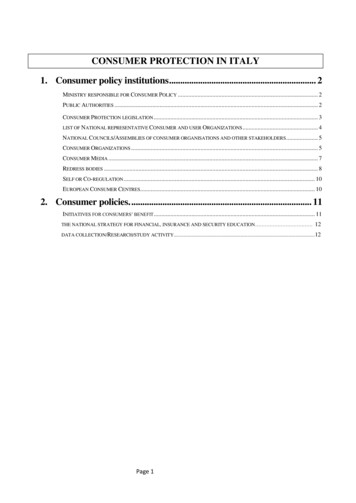

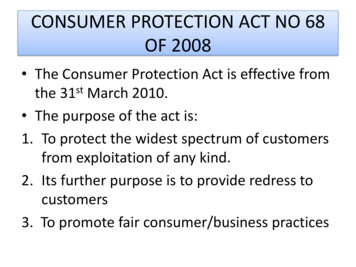

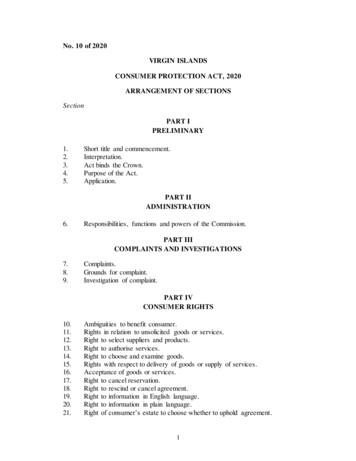
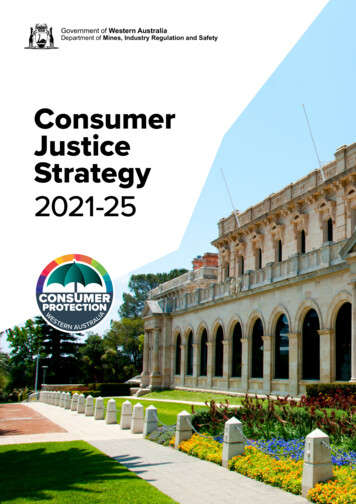

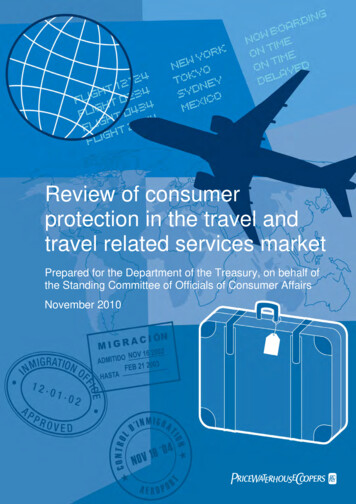
![Chapter 11. Consumer Protection. [Note] - Montgomery County, Maryland](/img/40/chap11.jpg)


